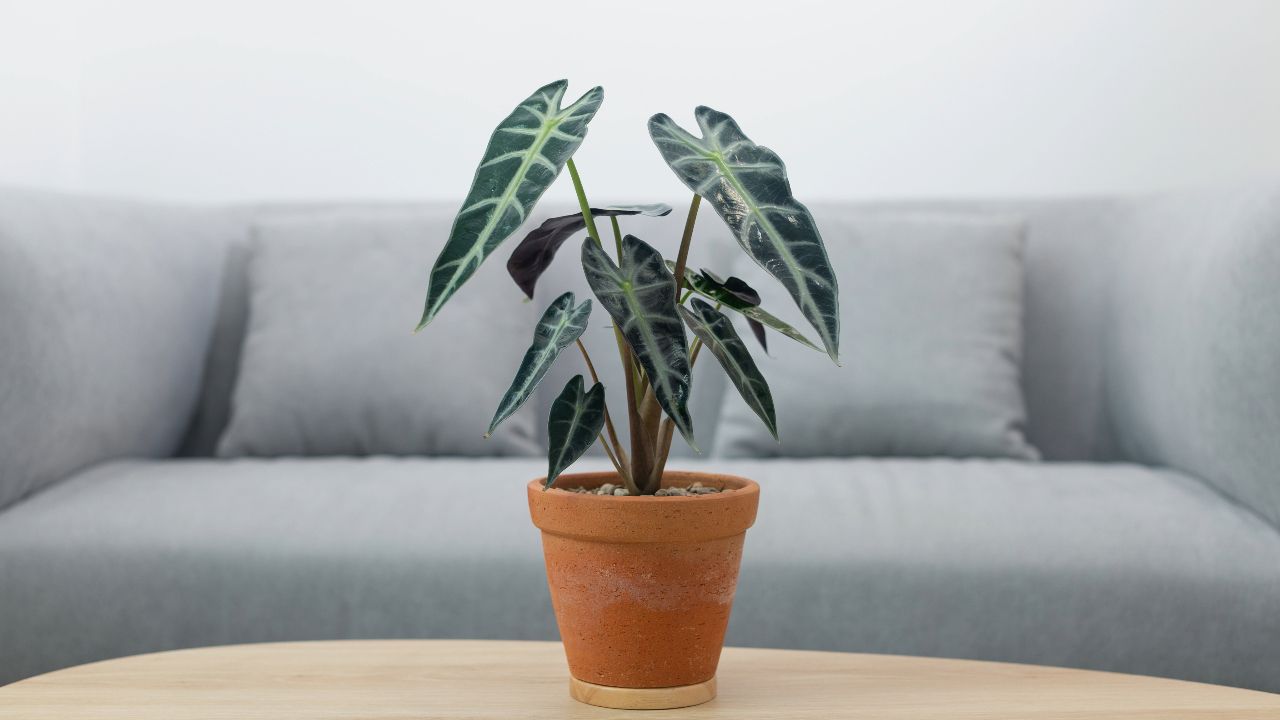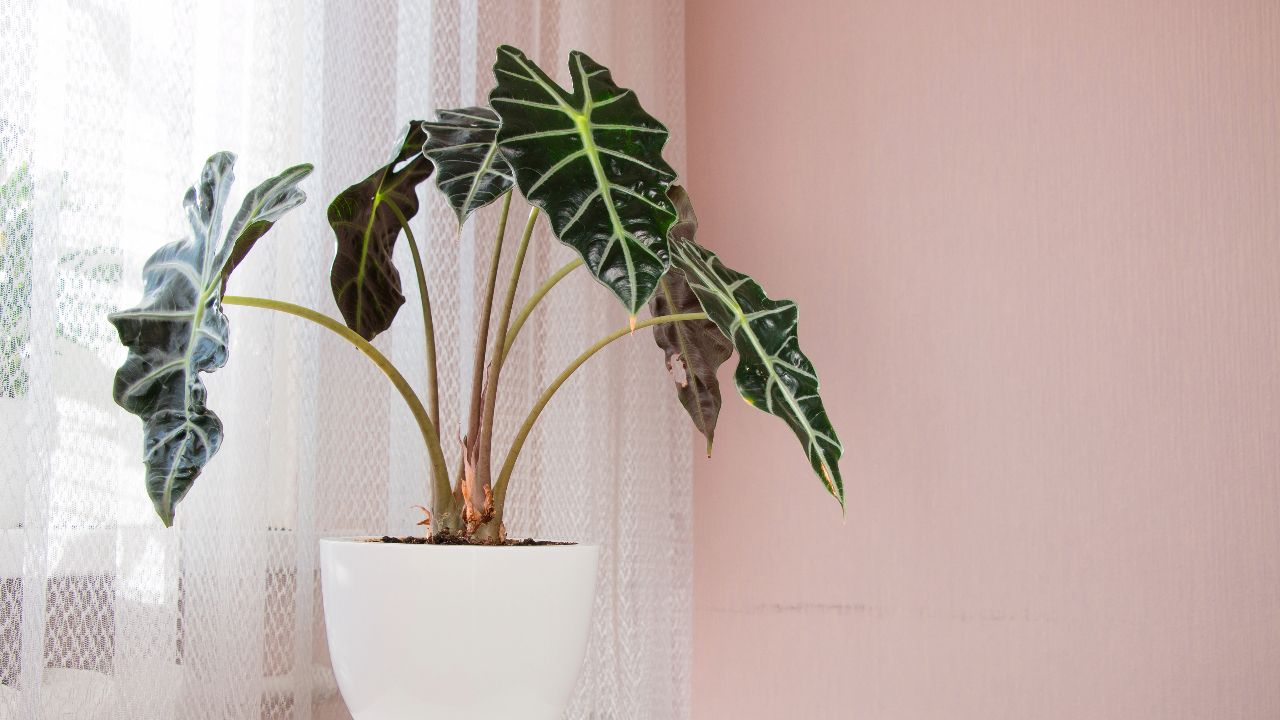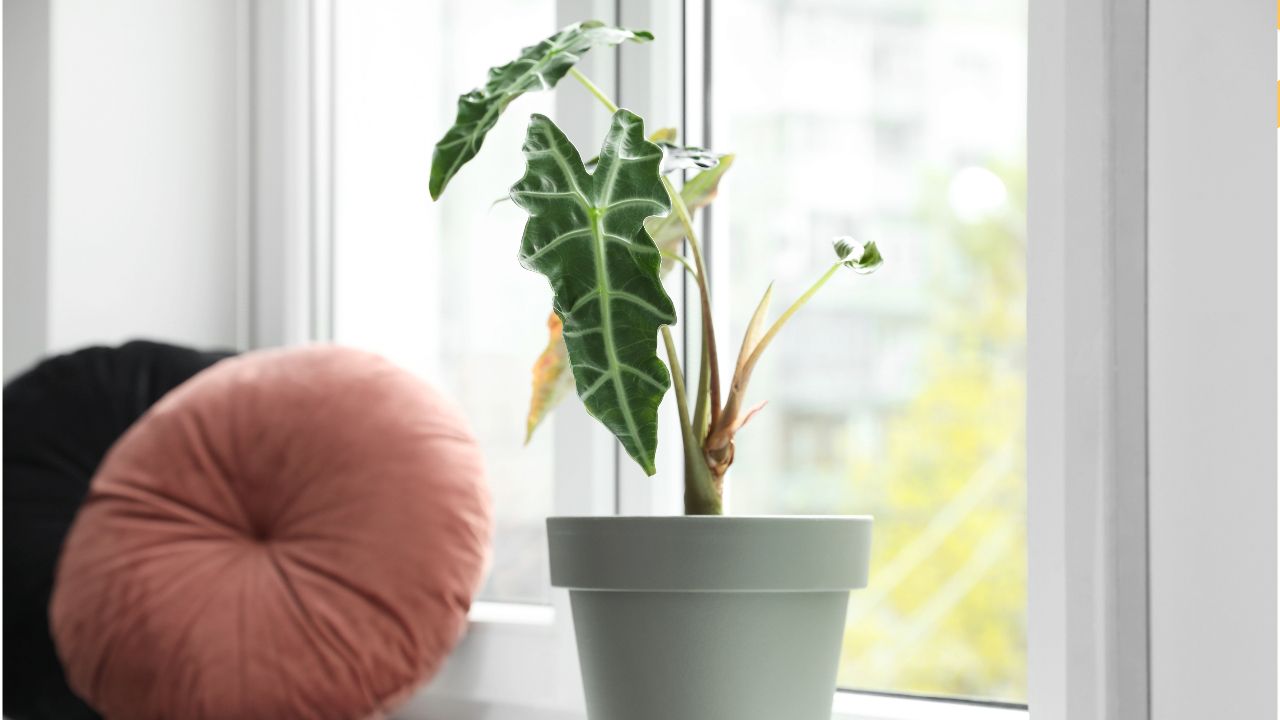
The lush world of indoor plants is vast, but among its varied inhabitants, the Alocasia stands tall with majestic allure. Originating from the diverse terrains of Asia and Eastern Australia, this tropical plant has been a cherished gem in horticultural circles, capturing hearts and transforming living spaces around the globe.
From the deep green, arrowhead-shaped leaves of some varieties to the dark gray-green of others, the Alocasia's visual appeal is undeniable. But it's not just about aesthetics. Known to many as the elephant ear plant because of its large, distinctive leaves, this plant offers more than just its grandeur. It's a symbol of nature's artistry and adaptability, having embarked on an extraordinary journey from the subtropical forest floors to becoming a favored addition in homes worldwide.
Beyond its beauty, the Alocasia plant holds secrets and care techniques that every enthusiast should delve into, ensuring they thrive and continue their legacy of elegance and charm.
Join our newsletter
Stay on top of the latest in landscaping and lawn care with one valuable tip right in your inbox every Saturday morning.
At a Glance: Alocasia Plant
- Common Names:
- Alocasia
- Elephant's ear
- African mask plant
- Botanical Identification: Alocasia spp.
- Plant Family: Araceae, commonly referred to as Aroid
- Type of Plant: A herbaceous perennial
- Growth Dimensions:
- Height: Ranges from 2–10 ft., depending on the species and variety
- Spread: Typically between 2-10 ft.
- Preferred Light Conditions:
- Indoors: Thrives in bright indirect light
- Outdoors: Prefers part shade
- Soil Preferences:
- Best in a loose, well-draining potting mix or crumbly loam
- Optimal Soil pH: A slightly acidic range of 5.5 to 6.5
- Blooming Details:
- Time: Primarily in spring and summer
- Flower Color: A subtle light butter-yellow, though it's worth noting that Alocasias rarely flower and when they do, they aren't particularly showy
- Climate Suitability: Best suited for USDA Hardiness Zones 10–12
- Natural Habitat: Originated from the tropical regions of Asia
- Safety Information:
- It's important to note that Alocasias are toxic and can be harmful if ingested by dogs, cats, or humans.

Bright Indirect Light: Alocasia's Preferred Illumination
The Alocasia, with its tropical roots, has specific lighting needs that ensure its vibrant growth and health. But what exactly are these requirements? Let's delve into the world of illumination for this majestic plant:
The Ideal Light Conditions for Vibrant Alocasia Growth
- Bright indirect light: This ensures the plant remains active and vital, mirroring the dappled light it would receive under a tree canopy in its native habitat.
- Eastern or Western exposure: Alocasias thrive best when placed near windows with eastern or western sun exposure, getting a balance of morning or late afternoon sun.
- Avoid excessive sun exposure: While they adore light, continuous exposure to direct sunlight can scorch their leaves.
Dangers of Direct Sunlight and Benefits of Indirect Light
- Direct Sunlight: Prolonged exposure can cause leaf burn, yellowing, or even fading of their characteristic deep green hue.
- Bright Indirect Light: Provides the necessary light without the harshness, ensuring leaves remain vibrant and healthy.
- Consistent Lighting: Alocasias prefer a consistent light source, so avoid shifting them between different light conditions frequently.
Whether you're new to the world of Alocasia plants or a seasoned enthusiast, understanding their light needs is crucial. Adapting your space to accommodate these requirements ensures that your plant not only survives but thrives, showcasing its full beauty and potential.

Understanding Root Rot: A Common Foe for Alocasia Plants
While the Alocasia plant is a magnificent addition to any indoor space, it is not without its vulnerabilities. One of the most common issues faced by these plants is root rot. Let's explore the causes, prevention methods, and how to tackle this problem should it arise:
Causes of Root Rot in Alocasia Plants
- Overwatering: One of the primary reasons, soggy soil can suffocate the plant's roots and promote fungal growth.
- Poor drainage: If the potting mix doesn't allow excess water to escape, it becomes a breeding ground for rot-inducing fungi.
- Compacted soil: This prevents roots from accessing air, leading to decay over time.
- Fungal infections: Certain fungi target plant roots, especially in conditions with high humidity and limited airflow.
Prevention, Detection, and Remediation Methods
- Watering Schedule: Adhere to a consistent watering schedule, ensuring the soil is moist but not waterlogged.
- Well-Draining Potting Mix: Use a mix rich in peat moss and orchid bark to promote drainage.
- Pots with Drainage Holes: Ensure your plant container has adequate drainage to prevent water accumulation.
- Check Roots Regularly: Healthy roots should be firm and white or light tan. Dark, mushy roots are a sign of rot.
- Isolate Affected Plants: If you detect root rot, immediately isolate the plant to prevent the spread of fungal spores to other plants.
- Root Treatment: Trim away affected root clumps and treat the healthy roots with a fungicide before repotting in fresh, well-draining potting mix.
Addressing root rot promptly and understanding its causes can be the difference between a thriving Alocasia and a struggling one. By staying vigilant and informed, you can ensure that this common adversary doesn't undermine your plant's health and beauty.
The African Mask Plant: A Unique Alocasia Variety
The Alocasia genus offers a myriad of stunning species, but the African Mask plant (commonly termed as the Alocasia 'Poly') stands out as an exquisite specimen. This plant, with its distinctive appearance, can transform any space into a tropical paradise.
Origin and Distinct Features of the African Mask Plant The African Mask plant, a native to the subtropical regions of Asia and Eastern Australia, is coveted for its unique, dark gray-green leaves that resemble the intricate patterns of an African mask. These leaves, with their arrowhead shape and flat or wavy edges, present a deep green hue that almost appears black in certain lighting, making it a visual treat.
How it Stands Out Among Other Alocasia Species
- Distinct Leaf Patterns: Unlike most Alocasia species, the African Mask plant boasts striking veins that contrast sharply against its dark leaves.
- Compact Growth: While many Alocasia plants grow tall, the African Mask plant remains a compact plant, making it perfect for indoor settings.
- High Humidity Lover: It thrives in a humid environment, often more so than other Alocasia plants.
- Visual Appeal: Its deep green, almost black foliage, sets it apart from other green indoor plants, ensuring it always remains the focal point.
The African Mask plant, while being a member of the Alocasia family, has carved its niche, solidifying its position as a must-have for plant enthusiasts and interior decor aficionados alike.
Join our newsletter
Stay ahead of the curve in all things outdoor.
Get the inside scoop on the latest landscaping, lawn care, and fencing trends with 1 actionable tip every Saturday morning.
Watering and Soil: Foundations of Alocasia Health
Nurturing an Alocasia plant to its full potential requires an understanding of its native environment and its unique soil and watering needs. Just as every plant has its distinct light requirements, the soil composition and moisture level play a pivotal role in ensuring that your Alocasia thrives.
The Importance of Well-Draining Potting Mix
- Avoids Root Rot: A well-draining potting mix ensures that excess water doesn't linger around the roots, preventing the onset of root rot and other fungal infections.
- Provides Adequate Airflow: Such a mix allows the roots to breathe, ensuring they don't suffocate from waterlogged conditions.
- Mimics Natural Habitat: In their native habitats, Alocasias grow in forest floors with loose, aerated soil. A well-draining potting mix replicates this environment, promoting healthy growth.
- Promotes Healthy Roots: Roots can spread easily, access nutrients, and remain strong in a mix that drains well.
Recognizing the Fine Line Between Moist and Soggy Soil Maintaining the perfect moisture level for your Alocasia is walking a fine line. While they thrive in a moist potting mix that replicates the humid environments of their native habitats, it's vital to ensure the soil doesn't become waterlogged. Soggy soil can lead to root decay, impede new growth, and create an environment ripe for plant diseases. Regularly check the soil's moisture level, ideally a couple of inches below the surface, and adjust your watering schedule accordingly. Remember, it's better to err on the side of slightly dry than overly wet.

Temperature, Humidity, and Alocasia: Striking the Right Balance
Alocasia plants, with their striking arrow-shaped leaves and intricate patterns, not only bring a touch of the tropics to your living space but also have specific environmental needs that mirror their native habitats. Achieving the right balance in terms of temperature and humidity is crucial for these plants to flourish.
Alocasia's Love for Humid Environments and Warm Temperatures
- Tropical Origins: Hailing from the humid environments of Asia and Eastern Australia, Alocasias thrive in conditions with high humidity. In fact, maintaining a humid environment is key to the plant's health and vitality.
- Warmth is Essential: Most Alocasia species prefer temperatures that hover between 65°F to 75°F during the day. Warm summer months are especially beneficial for actively growing Alocasias, allowing them to soak in the heat and channel it for growth.
Guarding Against Cold Drafts and Air Conditioning Pitfalls Alocasias, while resilient, are sensitive to sudden temperature fluctuations. Cold drafts, especially during winter, can be detrimental. Similarly, while air conditioners offer respite during hot spells, they can drastically reduce indoor humidity. Always position your Alocasia away from direct air conditioner drafts and consider using a pebble tray or humidifier to maintain optimum humidity levels.

Repotting and Growth: Nurturing Larger Floor Plants
Witnessing new growth in Alocasia plants is a rewarding experience for every plant enthusiast. As these indoor plants gradually evolve from compact plants to larger floor plants, periodic repotting becomes essential. Properly done, it can ensure the plant continues its healthy upward trajectory, displaying those unique arrow-shaped leaves and deep green hues.
The Joys of New Growth in Alocasias
- A Living Transformation: One of the joys of nurturing Alocasia plants is observing the emergence of new growth. This symbolizes a plant that's actively growing, especially during the warm summer months.
- Characteristics of Healthy Growth: Look for deep green, vibrant leaves, often with flat or wavy edges, and occasionally, the Alocasia produces seed pods which can be a fascinating addition.
Steps to Repot and Ensure Healthy Root Clumps
- Choose the Right Pot: Opt for a pot with a drainage hole to prevent soggy soil. A well-draining potting mix is crucial.
- Inspect the Roots: Healthy root clumps should be firm and free from signs of root rot or fungal infections.
- Positioning: Once repotted, place your Alocasia in a location with bright indirect light to encourage more growth.
Potential Pests and Diseases: Keeping Alocasia Safe
Like many indoor plant varieties, Alocasias can be susceptible to certain pests and diseases. It's crucial to understand the most common threats to these plants and how to counteract them to keep your Alocasia vibrant and thriving.
Common Pests and Their Prevention
- Spider Mites: One of the most common pests for Alocasia plants, spider mites are tiny creatures that suck the plant's sap. Their presence can lead to yellowing leaves and weaken the plant. To prevent them:
- Regularly mist your Alocasia to maintain a humid environment, as spider mites despise humidity.
- Examine the undersides of the leaves frequently and wipe them down with a damp cloth.
- Consider using natural predators like ladybugs to combat spider mites organically.
Recognizing and Treating Plant Diseases
- Fungal Infections: Manifesting as spots or a powdery substance on the leaves, fungal infections are a potential threat to Alocasia. To address them:
- Ensure your plant is in a well-draining potting mix to prevent soggy soil conditions.
- Avoid overhead watering, which can lead to moisture on the leaves.
- Use an organic fungicide as a proactive measure if you spot early signs.
With attentive care, understanding common pests, and proactive disease prevention, your Alocasia can remain a beautiful and healthy centerpiece in your indoor plant collection.
Joining the Alocasia Fan Club
Alocasias, with their alluring charm and distinct features, have captivated plant enthusiasts around the globe. Embracing these tropical treasures in your collection is not just about their aesthetic appeal, but the joy derived from nurturing and watching them flourish. As you embark on this journey with Alocasias, every new leaf unfurled is a testament to your dedication and care.
Join our newsletter
Stay ahead of the curve in all things outdoor.
Get the inside scoop on the latest landscaping, lawn care, and fencing trends with 1 actionable tip every Saturday morning.